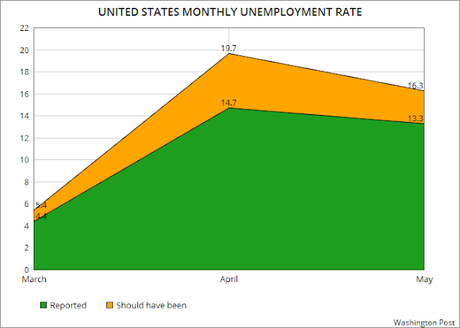
Most economists were surprised at the 13.3% unemployment rate for May when it was announced. They had expected it to be higher. They were right. The Labor Department says it miscalculated the rate -- a miscalculation that caused it to be 3 points lower than it should have been. And it wasn't just May. That same miscalculation occurred in March and April also.
Here is how the mistake was reported in The Washington Post:
When the U.S. government’s official jobs report for May came out on Friday, it included a note at the bottom saying there had been a major “error” indicating that the unemployment rate likely should be higher than the widely reported 13.3 percent rate
The special note said that if this “misclassification error” had not occurred, the “overall unemployment rate would have been about 3 percentage points higher than reported,” meaning the unemployment rate would be about 16.3 percent for May.
The Bureau of Labor Statistics, the agency that puts out the monthly jobs reports, said it was working to fix the problem.
“BLS and the Census Bureau are investigating why this misclassification error continues to occur and are taking additional steps to address the issue,” said a note at the bottom of the Bureau of Labor Statistics report
Some took this as a sign that President Trump or one of his staffers may have tinkered with the data to make it look better, especially since most forecasters predicted the unemployment rate would be close to 20 percent in May, up from 14.7 percent in April. But economists and former BLS leaders from across the political spectrum strongly dismissed that idea.
“You can 100% discount the possibility that Trump got to the BLS. Not 98% discount, not 99.9% discount, but 100% discount,” tweeted Jason Furman, the former top economist for former president Barack Obama. “BLS has 2,400 career staff of enormous integrity and one political appointee with no scope to change this number.”
Economists say the BLS was trying to be as transparent as possible about how hard it is to collect real-time data during a pandemic. The BLS admitted that some people who should have been classified as “temporarily unemployed” during the shutdown were instead misclassified as employed but “absent” from work for “other reasons.”
The “other reason” category is normally used for people on vacation, serving jury duty or taking leave to care for a child or relative. These are typically situations where the worker decides to take leave. But in this unusual pandemic circumstance, the “other reason” category was applied to some people staying at home and waiting to be called back.
This problem started in March when there was a big jump in people claiming they were temporarily “absent” from work for “other reasons.” The BLS noticed this and flagged it right away. In March, the BLS said the unemployment rate likely should have been 5.4 percent, instead of the official 4.4 percent rate. In April, the BLS said the real unemployment rate was likely about 19.7 percent, not 14.7 percent.

